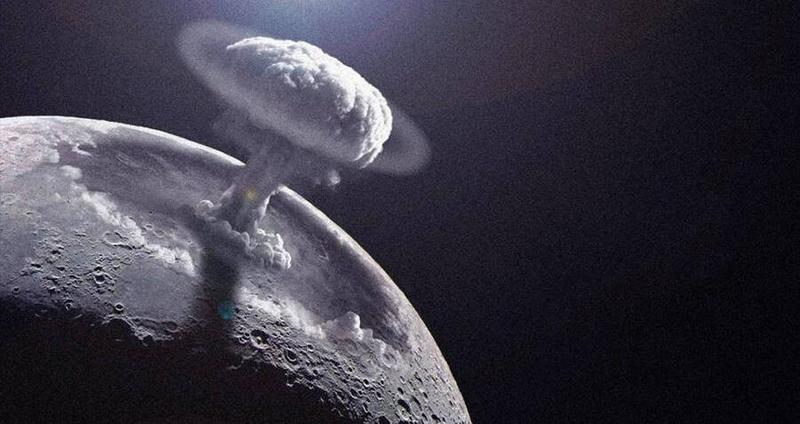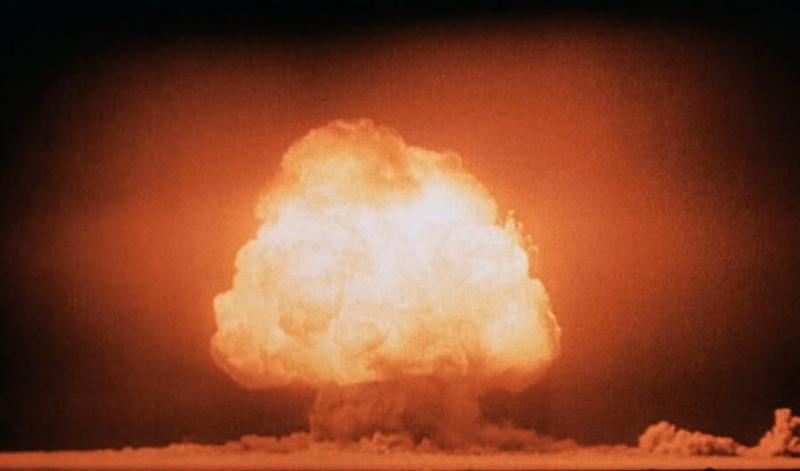What Happened When America Tried To Detonate A Hydrogen Bomb On The Moon
By Sarah Norman | December 12, 2023
The Race For Nuclear Power

During the tumultuous era of the Cold War in the 1950s, the United States and the Soviet Union found themselves locked in a tense and dangerous race to develop nuclear weapons, a race that escalated global tensions to unprecedented levels. In 1945, the United States had taken a significant lead by detonating the first nuclear bombs in history, dropping them on the Japanese cities of Hiroshima and Nagasaki. However, it became evident that the Soviets were determined to close the gap, and they successfully tested their first nuclear weapon in 1949, marking the start of a perilous nuclear arms race. This race not only defined the ideological rivalry between the two superpowers but also had far-reaching implications for international security, leading to a constant state of alert and an ever-present fear of mutually assured destruction that persisted throughout the Cold War.
The Hydrogen Bomb Was A Game Changer

In the early 1950s, the advancement of nuclear technology reached a pivotal moment with the development of the hydrogen bomb, often referred to as a thermonuclear bomb. The United States conducted its first successful test of this groundbreaking weapon in 1952, marking a significant leap in destructive power compared to the earlier atomic bombs. Hydrogen bombs were several hundred times more powerful, relying on a fusion reaction that harnessed the energy released by the fusion of hydrogen isotopes. This exponential increase in destructive capability elevated the stakes of the Cold War considerably, as both the United States and the Soviet Union raced to develop and stockpile these devastating weapons. The hydrogen bomb became a symbol of the terrifying potential for mass destruction during this era and served as a stark reminder of the perilous nuclear arms race that characterized the Cold War.
The Soviets Caught Up In 1955

In the first half of the 1950s, the Soviet Union found itself trailing behind the United States in the relentless race for nuclear arms. While the United States had taken an early lead by detonating the first hydrogen bomb in 1952, the Soviets struggled to keep pace with their American counterparts. It wasn't until 1955 that the Soviets made a significant breakthrough, successfully detonating their first thermonuclear weapon. This marked a crucial turning point in the nuclear arms race, as the Soviet Union demonstrated its capability to match the United States in terms of destructive power. However, it's important to note that this period of Soviet catch-up would eventually spill over into the space race, where they would achieve a series of remarkable milestones that would further intensify the Cold War competition between the two superpowers.
Russia's Expansion Into Space Terrified The United States

In 1957, the world witnessed a momentous event that sent shockwaves far beyond the Earth's atmosphere: the Soviet Union successfully launched the first artificial satellite, Sputnik, into orbit. This remarkable achievement marked a pivotal turning point in the Cold War rivalry, leaving the United States deeply worried about the technological gap between the superpowers. Sputnik's ominous beeping transmission served as a constant reminder of Soviet prowess and innovation in space technology, sparking fears that the USSR had gained the upper hand not only in space exploration but also in military capabilities, as the same rocket technology could potentially be used for intercontinental ballistic missiles. This realization prompted the United States to embark on an audacious, top-secret plan in 1958 to regain its position at the forefront of the space race and bolster its national security.
Project A119

In the wake of the startling launch of Sputnik by the Soviet Union, the U.S. Air Force initiated a covert project with the cryptic title, "A Study of Lunar Research Flights," which would later be known as Project A119. Behind this enigmatic name lay a daring plan to detonate a nuclear bomb on the lunar surface. The project engaged some of the world's foremost nuclear scientists, many of whom were affiliated with the Armour Research Foundation in Chicago, with Leonard Reiffel being a notable figure among them. Before embarking on Project A119, the Air Force sought insights from leading scientists regarding the potential consequences of a nuclear explosion on the Moon, recognizing the need to understand the scientific and strategic implications of such a dramatic endeavor.
The Military Knew Where They Wanted To Detonate The Bomb

Project A119 was not just a theoretical exercise; the U.S. military meticulously planned the detonation of a bomb on the Moon with a specific objective in mind. The Air Force sought to ensure that a nuclear blast on the lunar surface would be visible to observers on Earth, and this mission had a profound underlying purpose: to assert American superiority in the ongoing Cold War rivalry with the Soviet Union. To achieve this, the Project A119 team devised a strategic approach, deciding to target the terminator, which is the line separating the dark and light sides of the Moon. This choice was made with the intention of maximizing the visibility of the explosion and making a powerful statement about the technological prowess of the United States to the world
Believe It Or Not, There Were Some Issues With Nuking The Moon

The notion of the U.S. military firing a hydrogen bomb at the Moon came with a complex set of pros and cons. On the positive side, such an audacious demonstration of technological prowess could have showcased American superiority in the midst of the Cold War, potentially bolstering national confidence and signaling strength to adversaries. It might have also served as a deterrent, sending a message that the U.S. was willing to take bold actions to maintain its strategic advantage. However, the cons of such an act were equally significant. The detonation of a hydrogen bomb on the Moon would undoubtedly have left a massive and enduring crater, permanently altering the lunar surface, which could have been viewed as an act of environmental desecration. Moreover, the potential for triggering a massive public backlash, both domestically and internationally, was a considerable risk, as many would likely have protested against such a provocative and destructive action, which could have had diplomatic repercussions and damaged America's global reputation.
Look At The Upside

The concept of nuking the Moon was fraught with downsides and potential consequences, scientists did perceive one potential upside to the audacious plan. They believed that such a detonation might yield valuable scientific insights about lunar chemistry and the Moon's internal structure. As part of Project A119, the proposal included the placement of instruments on the Moon's surface to measure the effects of the explosion. This data could have provided researchers with unique data points for studying the Moon, shedding light on its composition and geological characteristics. Leonard Reiffel, a scientist on the project explained:
I made it clear at the time there would be a huge cost to science of destroying a pristine lunar environment, but the US Air Force were mainly concerned about how the nuclear explosion would play on earth.
The Whole Thing Was Supposed To Be a PR Move

At its core, Project A119 was primarily centered on eliciting a reaction from the public and sending a clear message of American superiority during the height of the Cold War. The plan was designed with the understanding that if a nuclear bomb were to detonate on the Moon's surface, it would produce a visible and unmistakable mushroom cloud that billions of people back on Earth could witness. This highly public spectacle was intended to serve as a powerful propaganda tool, signaling to both the American population and the Soviet Union that the United States had achieved a momentous milestone by beating them to the Moon, even if it involved such a provocative and destructive act. Reifell explained to the Guardian in 2000:
It was clear the main aim of the proposed detonation was a PR exercise and a show of one-upmanship. The Air Force wanted a mushroom cloud so large it would be visible on earth.
The World Would Be Totally Different If The Plan Was Carried Out

If the U.S. Air Force had carried out Project A119 and detonated a nuclear bomb on the Moon, it would have undoubtedly reshaped the trajectory of the space race and global geopolitics. Rather than a race to put a man on the Moon, the Cold War rivals would likely have intensified their nuclear competition in space, potentially triggering a dangerous and unpredictable arms race on celestial bodies. The negative response from people on Earth would have been overwhelming, further complicating the already tense relations between the superpowers. The long-term consequences of such an action would have been profound and unpredictable, making it difficult to foresee how the world would have evolved in the wake of such a provocative act.
Project A119 Wasn't Entirely Crazy, At Least Not To The Military

The United States' strong determination to demonstrate its military might in space during the Cold War can be attributed to a combination of factors, driven by the intense rivalry with the Soviet Union. In the climate of fervent competition, Project A119 garnered significant support as a means to assert American dominance. The Soviet Union's successful testing of the intercontinental ballistic missile (ICBM) was a watershed moment, as it gave them the capability to potentially launch nuclear attacks on U.S. soil. The knowledge that ICBMs carried Sputnik into space underscored the reach of this new missile technology. This development fueled American concerns about the vulnerability of their homeland. As the Soviets continued to make advancements in space exploration, including launching satellites on ICBMs, the U.S. Air Force saw sending nuclear weapons to space as a logical step to not only counterbalance Soviet achievements but also to demonstrate that the United States was prepared to take bold and assertive actions to safeguard its national security interests in the face of a formidable adversary.

